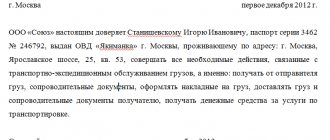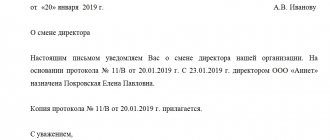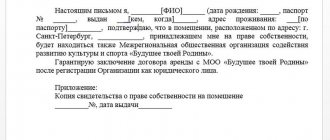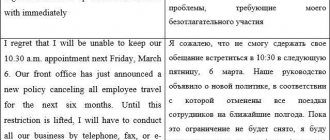Information letter structure: 5 required sections
An information letter is one of the most common types of business letters. Its main task is to convey specific information to a specific person:
- subordinates;
- colleagues;
- partners;
- clients;
- potential clients.
In practice, it is customary to comply with certain requirements for the structure and text of the document. It is compiled only in an official business style, characterized by a small volume (most often 1 page), the absence of emotionally charged phrases and colloquial expressions. Usually the text is compiled according to this plan:
- In the upper right corner, indicate the position and full name of the person to whom the message is addressed. Usually this is the chief director of the enterprise, who in the future must familiarize all employees or some colleagues with the text of the letter.
- In the upper left corner indicate the number and date, which is written in the outgoing correspondence log.
- Then comes the text itself - this is the main content of the document. It usually begins with the phrase: “We hereby notify you that...”. Next, the essence of the notification is stated in one or more sentences (a numbered list is often used).
- If necessary, appendices are written after the text - a list of documents that are attached to the message.
- Next, the author-sender indicates his position, the name of the company, puts a stamp and signature, and a transcript of the signature (last name, initials).
Expert opinion
Chadova Svetlana
Leading HR specialist, lawyer, labor law consultant, website expert
In addition to this material, we recommend that you familiarize yourself with a sample of writing cover letters for documents; see details here.
Types of business letters
One of the key places where correspondence is used is in the business environment. Companies regularly communicate with each other and within the firm.
The basic criteria for classifying business letters include:
- Territorial attribute - within a city, country or pair of states.
- Delivery method - paper correspondence, fax and email.
- The status of subjects is communication between legal entities and individuals.
- The number of recipients is one object or group of persons.
- The subject of communication is management issues, legal proceedings, personal exchange of information and others.
- Level of regulation – formal (with a strict structure) and informal messages.
It is also possible to identify other classification criteria. They are based on problems, goals and hierarchy of issues to be solved.
Types of newsletters: 5 ready-made samples
There are quite a few types of newsletters. Their main purpose is to inform the interlocutor, which may involve performing a variety of tasks - notification, statement, confirmation of intentions, advertising message (commercial offer) and much more.
Notice (notice)
The main task is to notify the client, partner, colleagues, employees of branches, and other departments about the most important company events expected in the near future:
- change of director, chief accountant and other employees;
- change of details;
- change of legal or actual address;
- preparation for inventory;
- changing the work week, reducing hours, etc.
The sender can also report on any informal events - preparation for a corporate party, celebration of the company’s anniversary, exhibition, etc.
Confirmation of intent
This letter can serve as an informational occasion to “remind” yourself or simply confirm intentions in response to a request. For example, a company is negotiating a deal, but at various times for some reason it periodically interrupts them. Subsequently, management came to the conclusion that the deal would indeed be profitable, so a letter of confirmation of intentions could be sent to the partner.
Explanation
Such a letter usually comes from government bodies and departments - the Federal Tax Service, the Federal Antimonopoly Service, the Ministry of Emergency Situations, Rostrud and many others. A company can also draw up its own letter based on these documents. The main purpose of the text is to explain in detail your position when disagreements arise (or to prevent them).
Reminder
In such a letter, the partner seeks to warn the other partner about the end of the deadline for transferring the advance or final payment under the supply agreement, provision of services, etc. Often, the preparation of this document becomes the last resort, after which the company is forced to go to court - a corresponding warning can also be included in the text.
Advertising letter (commercial offer)
When drawing up commercial proposals, a more informal style of text and message design is allowed and even encouraged. The main task of the document is to attract the attention of the interlocutor and make him want to learn more about the product or service, i.e. interest and encourage contact. It is a mistake to think that a commercial offer can immediately “sell” a product. In fact, his main task is to “sell” the meeting or phone call.
Service response letters
Since a number of texts sent require a response from the recipient, forms of letters with consent and refusal have been introduced in the business environment. They are used for requests, proposals, requests and a number of other texts.
Letter of refusal
Disagreement involves rejecting what is stated in the message.
Example - the company’s management decided not to accept the proposal of the marketing department and refused to develop an advertising campaign.
Letter of consent
If an organization is interested in participating in an event or implementing any technology, it agrees.
For example, the company's administration supported the idea of attending the economic forum and agreed to the invitation.
Service letters with confirmation, guarantee, commitment
Large companies use correspondence. In most cases, the forms have a standard form. Let's look at key examples of memos.
Letter of recommendation
Guidelines are used in the corporate world to evaluate the characteristics of individuals and legal entities.
This is a kind of PR of the object for others. As an example, you can note a letter of recommendation to an employee upon dismissal.
Confirmation letter
Confirmation is sent when it is required to confirm the receipt of any data.
For example, a company sent a request for participation, the organizing committee responded that it accepted their application and it is under consideration. Correspondence is the key to ensuring that your message will not be lost. Often such messages are sent automatically when an email is received.
Letter of guarantee
The format involves providing information about the company’s obligations to third parties. Sent to both partners and consumers of goods and services.
Example - a manufacturing company sends warranty messages to customers stating that in the event of a defect, they undertake to compensate costs at double the rate and a request to agree on conditions.
Etiquette letters
Etiquette letters, as a rule, also have a standardized form and are used repeatedly for typical situations. The recipient's personal data and date are inserted into the sample. They are not as formalized as administrative ones, but they also have a structure.
Gratitude
For special services to the company, it is permissible to use various positive sanctions. The simplest one is a thank you letter.
For example, for high turnover indicators, an employee was sent an electronic text expressing gratitude and justification for gratitude.
Congratulation
A small format text file containing kind words and wishes to the person having a special occasion.
Example - the manager’s secretary regularly sends birthday greetings to the company’s employees on behalf of the director.
Apology
This option is often used in relation to clients by company management.
Example - a consumer is not satisfied with the quality of the services provided and reported this to the customer service department. In response, authorized employees sent an apology in writing.
Condolences
When a misfortune occurs in a person's family, it is customary to send texts expressing condolences.
Applies in the event of the death of an employee or one of his relatives.
How to write a newsletter so that it is read
A lot has been written, talked about and filmed on how to make a beautiful and effective template, but very little attention is paid to the text of newsletters. Let's fix this and reveal the little secrets of writing and designing text.
One letter - one thought
Remember the old humorous scene: “I brought some notes here... Here to play, here not to play, and here they wrapped the fish.” It is advisable that your email does not create the same feeling for the client.
Avoid long preambles
Try to interest the client as much as possible with the first phrase so that he continues to read from sentence to sentence. Each subsequent phrase should further increase interest in going to the site.
The Wikium newsletter is a prime example of how to do it. First there is a bright headline, then animation and only then six lines + a CTA button that spark curiosity.
Simplify your letter structure
Moreover, if you are sending Plain-text - these letters are most often used when personal communication is implied and it is good if it is immediately clear what the interlocutor is talking about.
A person spends 1.7 seconds processing advertisements in popular magazines. Advertising in industry publications - 3.2 seconds. Poster - 1.5 sec. Advertising in a letter - 2 sec. Advertising on a banner - a second. Obviously, marketing messages need to be delivered at lightning speed.
— Phil Barden
The simpler you explain what you want from a subscriber, the higher the chance that he will perform the target action.
An example of a newsletter from a company that deals with jewelry. It seems that the client received a personal letter. The design is quite simple: just one link, a signature, everything fits into the first viewing screen.
Keep sentences and paragraphs short
In the era of mobile devices, there is no need to explain that users consume a lot of information from phones and tablets. Paragraphs of one or two sentences are already becoming a rule of good form.
Try to arrange the information in a similar way to LinguaLeo - three paragraphs / two lines / two sentences. The call button deserves special attention - it’s just a little prank, a slight accent. For example, by the first of April the company launched a newsletter with information about how you can mine in their training service. It's great when you can joke with your subscribers and they are ready for it










